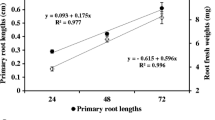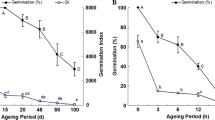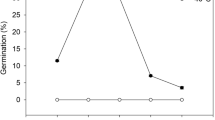Abstract
Maturity of the seeds can affect their potential longevity. It has been shown that components related to seed quality develop after the moment when the seed has reached its maximum dry mass, known as harvest maturity. In this state seeds have already developed critical adaptation mechanisms, such as detoxification of reactive oxygen species (ROS), which allow it to survive accelerated water loss. The objective of the present study was to determine the effect of maturity on physiological and biochemical indicators associated with the germination and vigour of tobacco seed. Tobacco seeds were collected at 14, 21, 28, 35, 42, 49 and 56 days after anthesis, the moisture content, dry and fresh mass of 1000 seeds and germination power were determined and the vigour of the seeds was evaluated through accelerated aging test and electrolytes leakage. In addition, generation rate of O2·− and H2O2 content were determined, as well as enzyme activity Superoxide Dismutase and Catalase. Tobacco seeds collected at 35 DAA showed superior vigor as a result of greater tolerance to accelerated aging conditions and cell membrane integrity, reflected in decreased electrolyte leakage values, as a consequence of an adequate oxidative balance. The results showed that there is a close relationship between antioxidant enzyme activity, especially CAT activity, and seed development. CAT enzyme activity levels suggest that hydrogen peroxide scavenging may be crucial to avoid oxidative stress on the way to the acquisition of desiccation tolerance in tobacco seeds.





Similar content being viewed by others
Code availability
Not applicable.
Availability of data and material
Not applicable.
References
Aebi H (1984) Catalase in vitro. Methods Enzymol 105:121–126. https://doi.org/10.1016/S0076-6879(84)05016-3
Bailly C, Audigier C, Ladonne F, Wagner MH, Coste F, Corbineau F, Côme D (2001) Changes in oligosaccharide content and antioxidant enzyme activities in develo** bean seeds as related to acquisition of drying tolerance and seed quality. J Exp Bot 52(357):701–708. https://doi.org/10.1093/jexbot/52.357.701
Bailly C, Leymarie J, Lehner A, Rousseau S, Côme D, Corbineau F (2004) Catalase activity and expression in develo** sunflower seeds as related to drying. J Exp Bot 55(396):475–483. https://doi.org/10.1093/jxb/erh050
Battaglia M, Olvera-Carrillo Y, Garciarrubio A, Campos F, Covarrubias AA (2008) The enigmatic LEA proteins and other hydrophilins. Plant Physiol 148:6–24. https://doi.org/10.1104/pp.108.120725
Bewley JD, Bradford KJ, Hilhorst HWM, Nonogaki H (2013) Seeds: Physiology of development, germination and dormancy. 3ra edn. Springer, New York. https://doi.org/10.1007/978-1-4614-4693-4
Bradford MM (1976) A rapid and sensitive method for the quantitation of microgram quantities of protein utilizing the principle of protein-dye binding. Anal Biochem 72:248–254. https://doi.org/10.1016/0003-2697(76)90527-3
Buitink J, Leprince O (2004) Glass formation in plant anhydrobiotes: survival in the dry state. Cryobiology 48:215–228. https://doi.org/10.1016/j.cryobiol.2004.02.011
Chaitanya KSK, Naithani SC (1994) Role of superoxide, lipid peroxidation and superoxide dismutase in membrane perturbation during loss of viability in seeds of Shorea robusta Gaertn.f. New Phytol 126:623–627. https://doi.org/10.1111/J.1469-8137.1994.TB02957.X
Chaudhuri A, Singh K, Kar R (2013) Interaction of hormones with reactive oxygen species in regulating seed germination of Vigna radiata (L.) Wilczek. J Plant Biochem Physiol. https://doi.org/10.4172/2329-9029.1000103
Chen H, Osuna D, Colville L, Lorenzo O, Graeber K, Kuster H, Leubner-Metzger G, Kranner I (2013) Transcriptome-wide map** of pea seed ageing reveals a pivotal role for genes related to oxidative stress and programmed cell death. PLoS ONE 8(10):1–15. https://doi.org/10.1371/journal.pone.0078471
Chia TYP, Pike MJ, Rawsthorne S (2005) Storage oil breakdown during embryo development of Brassica napus (L.). J Ethnopharmacol 56(415):1285–1296. https://doi.org/10.1093/jxb/eri129
Crowe JH, Crowe LM, Oliver AE, Tsvetkova N, Wolkers W, Tablin F (2001) The trehalose myth revisited: Introduction to a symposium on stabilization of cells in the dry state. Cryobiology 43:89–105. https://doi.org/10.1006/cryo.2001.2353
De Koning R, Kiekens R, Toili MEM, Angenon G (2021) Identification and expression analysis of the genes involved in the raffinose family oligosaccharides pathway of Phaseolus vulgaris and Glycine max. Plants 10(7):1465. https://doi.org/10.3390/plants10071465
del Río LA, Gómez M, Leal A, López-Gorgé J (1977) A more sensitive modification of the catalase assay with the Clark oxygen electrode. Application to the kinetic study of the pea leaf enzyme. Anal Biochem 80:409–415. https://doi.org/10.1016/0003-2697(77)90662-5
Ellis RH (2019) Temporal patterns of seed quality development, decline, and timing of maximum quality during seed development and maturation. Seed Sci Res 29(2):135–142. https://doi.org/10.1017/S0960258519000102
Ellis RH, Hong TD, Jackson MT (1993) Seed production environment, time of harvest, and the potential longevity of seeds of three cultivars of rice (Oryza sativa L.). Ann Bot 72(6):583–590. https://doi.org/10.1006/ANBO.1993.1148
Engelmann F (2020) Genetic resources: seeds conservation. In: Landscape and land capacity. CRC Press, pp 123–127. https://doi.org/10.1201/9780429445552-17
Espino M, Espino E (2012) Catálogo de variedades comerciales de tabaco cubano. Instituto de Investigaciones del Tabaco, Grupo Empresarial de Tabaco de Cuba, Ministerio de la Agricultura, La Habana
Farrant JM, Moore JP, Hilhorst HW (2020) Unifying insights into the desiccation tolerance mechanisms of resurrection plants and seeds. Front Plant Sci 11:1–3. https://doi.org/10.3389/fpls.2020.01089
García M, Andino V (2002) Tecnología de bandejas flotantes en la producción de plántulas de tabaco en Cuba. CUBATABACO 3(1):30–33
García V, Santana N, Mena E (2015) ‘Burley Pinar 2010’: Primer cultivar cubano de tabaco burley resistente al marchitamiento por fusarium (Fusarium oxysporum) y a otras enfermedades de importancia en el cultivo. Cultivos Tropicales 36(2):91
Guéraud F, Atalay M, Bresgen N, Cipak A, Eckl PM, Huc L, Jouanin I, Siems W, Uchida K (2010) Chemistry and biochemistry of lipid peroxidation products. Free Rad Res 44(10):1098–1124. https://doi.org/10.3109/10715762.2010.498477
Halliwell B, Gutteridge JMC (2015) Free radicals in biology and medicine. Oxford University Press, New York. https://doi.org/10.1093/acprof:oso/9780198717478.001.0001
Harrington JF (1972) Seed storage and longevity. In: Kozlowski TT (ed) Seed biology, vol 3. Academic Press, New York, pp 145–245
He W, Wang L, Lin Q, Yu F (2021) Rice seed storage proteins: biosynthetic pathways and the effects of environmental factors. J Integr Plant Biol 63(12):1999–2019. https://doi.org/10.1111/jipb.13176
Hernández Y, León Y, Hernández JM, Monroy AL (2004) Nuevos sustratos para la producción de plántulas de tabaco en semilleros flotantes. CUBATABACO 5(2):15–19
Hoekstra FA, Golovina EA, Van Aelst AC, Hemminga MA (1999) Imbibitional leakage from anhydrobiotes revisited. Plant, Cell Environ 22:1121–1131. https://doi.org/10.1046/J.1365-3040.1999.00491.X
Hoekstra FA, Golovina EA, Buitink J (2001) Mechanisms of plant desiccation tolerance. Trends Plant Sci 6(9):431–438. https://doi.org/10.1016/S1360-1385(01)02052-0
Huang H, Song S (2013) Change in desiccation tolerance of maize embryos during development and germination at different water potential PEG-6000 in relation to oxidative process. Plant Physiol Biochem 68:61–70. https://doi.org/10.1016/j.plaphy.2013.02.029
ISTA (2016) International rules for seed testing. International seed testing association, Bassersdorf
Jianhua Z, Mcdonald MB (1997) The saturated salt accelerated aging test for small-seeded crops. Seed Sci Technol 25(1):123–131
Kambhampati S, Aznar-Moreno JA, Bailey SR, Arp JJ, Chu KL, Bilyeu KD, Durrett TP, Allen DK (2021) Temporal changes in metabolism late in seed development affect biomass composition. Plant Physiol 186(2):874–890. https://doi.org/10.1093/plphys/kiab116
Khan MB, Gurchani MA, Freed S, Jabran K, Hussain M (2014) Osmopriming improves the emergence, growth, nutrient uptake and soluble sugar contents of wheat seedlings. Soil Environ 33(2):142–148
Kumutha D, Ezhilmathi K, Sairam RK, Srivastava GC, Deshmukh PS, Meena RC (2009) Waterlogging induced oxidative stress and antioxidant activity in pigeonpea genotypes. Biol Plant 53:75–84. https://doi.org/10.1007/s10535-009-0011-5
Kurek K, Plitta-Michalak B, Ratajczak E (2019) Reactive oxygen species as potential drivers of the seed aging process. Plants 8(6):2–13. https://doi.org/10.3390/plants8060174
Lee YP, Baek KH, Lee HS, Kwak SS, Bang JW, Kwon SY (2010) Tobacco seeds simultaneously over-expressing Cu/Zn- superoxide dismutase and ascorbate peroxidase display enhanced seed longevity and germination rates under stress conditions. J Exp Bot 61(9):2499–2506. https://doi.org/10.1093/jxb/erq085
Lehner A, Bailly C, Flechel B, Poels P, Côme D, Corbineau F (2006) Changes in wheat seed germination ability, soluble carbohydrate and antioxidant enzyme activities in the embryo during the desiccation phase of maturation. J Cereal Sci 43(2):175–182. https://doi.org/10.1016/j.jcs.2005.07.005
Leprince O, Pellizzaro A, Berriri S, Buitink J (2017) Late seed maturation: drying without dying. J Exp Bot 68(4):827–841. https://doi.org/10.1093/jxb/erw363
Lima MI, Luiz E, Costa L, Emídio E, Costa CE, Barros S (2015) Determination of harvest maturity in Capsicum baccatum L. seeds using physiological and biochemical markers. Aust J Crop Sci 9(11):1010
Liu U, Cossu TA, Davies RM, Forest F, Dickie JB, Breman E (2020) Conserving orthodox seeds of globally threatened plants ex situ in the Millennium Seed Bank, Royal Botanic Gardens, Kew, UK: the status of seed collections. Biodivers Conserv 29(9):2901–2949. https://doi.org/10.1007/s10531-020-02005-6
Marcos-Filho J (2015) Seed vigor testing: An overview of the past, present and future perspective. Sci Agric 72(4):363–374. https://doi.org/10.1590/0103-9016-2015-0007
Marklund S, Marklund G (1974) Involvement of the superoxide anion radical in the autoxidation of pyrogallol and a convenient assay for superoxide dismutase. Eur J Biochem 47:469–474. https://doi.org/10.1111/J.1432-1033.1974.TB03714.X
Martínez-Espinosa Y, Pérez-Rodríguez JL, Santiesteban-Toca CE, Báez-Perez EL (2016) Sistema informático para contar semillas de Nicotiana tabacum. Cult Trop 37:106–110
Mascher M, Schreiber M, Scholz U, Graner A, Reif JC, Stein N (2019) Genebank genomics bridges the gap between the conservation of crop diversity and plant breeding. Nat Genet 51(7):1076–1081. https://doi.org/10.1038/s41588-019-0443-6
Matilla AJ (2021) The orthodox dry seeds are alive: a clear example of desiccation tolerance. Plants 11(1):20. https://doi.org/10.3390/plants11010020
Meitzel T, Radchuk R, McAdam EL, Thormählen I, Feil R, Munz E, Hilo A, Geigenberger P, Ross JJ, Lunn J (2021) Trehalose 6-phosphate promotes seed filling by activating auxin biosynthesis. New Phytol 229(3):1553–1565. https://doi.org/10.1111/nph.16956
MINAGRI (2012) Instructivo técnico para el cultivo del tabaco. Editorial AGRINFOR, Artemisa
Mira S, Estrelles E, González-Benito ME (2015a) Effect of water content and temperature on seed longevity of seven Brassicaceae species after 5 years of storage. Plant Biol 17:153–162. https://doi.org/10.1111/plb.12183
Mira S, Veiga-Barbosa L, González-Benito ME, Pérez-García F (2015b) Conductivity test in seeds of different passion flower species. Pesq Agrop Brasil 50(6):510–513. https://doi.org/10.1590/S0100-204X2015000600010
Morscher F, Kranner I, Arc E, Bailly C, Roach T (2015) Glutathione redox state, tocochromanols, fatty acids, antioxidant enzymes and protein carbonylation in sunflower seed embryos associated with after-ripening and ageing. Ann Bot 116:669–678. https://doi.org/10.1093/aob/mcv108
Navarro M, Febles G, Herrera RS (2015) Vigor: essential element for seed quality. Cuban J Agric Sci 49(4):447–458
Nkang A, Umoh EO (1997) Six month storability of five soybean cultivars as influenced by stage of harvest, storage temperature and relative humidity. Seed Sci Technol 25(1):93–99
Patterson BD, MacRae EA, Ferguson IB (1984) Estimation of hydrogen peroxide in plant extracts using titanium (IV). Anal Biochem 139:487–492. https://doi.org/10.1016/0003-2697(84)90039-3
Pérez-Rodríguez JL, Torrecilla G, Ruiz O, Rodríguez RC, Lorente GY, Martínez-Montero ME, González JL (2016) Efecto de la madurez en la crioconservación de semillas de Nicotiana tabacum L. Cult Tropi 37:99–105
Pérez-Rodríguez JL, Escriba RCR, González GYL, Olmedo JLG, Martínez-Montero ME (2017) Effect of desiccation on physiological and biochemical indicators associated with the germination and vigor of cryopreserved seeds of Nicotiana tabacum L. cv. Sancti Spíritus 96. In Vitro Cell Devl Biol-Plant 53(4):440–448. https://doi.org/10.1007/s11627-017-9857-y
Pieta Filho C, Ellis RH (1991) The development of seed quality in spring barley in four environments. I. Germination and longevity. Seed Sci Res 1(3):163–177
Pino LA (2010) Sancti Spiritus 96 variedad de tabaco negro resistente al moho azul, a la pata prieta y al virus del mosaico del tabaco. Tobacco Irrigation 1(1):18–19
Rajjou L, Debeaujon I (2008) Seed longevity: survival and maintenance of high germination ability of dry seeds. C R Biol 331:796–805. https://doi.org/10.1016/j.crvi.2008.07.021
Rao NK, Hanson J, Dulloo ME, Ghosh K, Novell D, Larinde M (2007) Manual para el manejo de semillas en bancos de germoplasma. Manuales para Bancos de Germoplasma No. 8. Bioversity International, Roma, Italia
Sanhewe AJ, Ellis RH (1996) Seed development and maturation in Phaseolus vulgaris I. Ability to germinate and to tolerate desiccation. J Exp Bot 47(300):949–958. https://doi.org/10.1093/jxb/47.7.949
Solberg SØ, Yndgaard F, Andreasen C, Von Bothmer R, Loskutov IG, Asdal Å (2020) Long-term storage and longevity of orthodox seeds: a systematic review. Front Plant Sci 11:1–14. https://doi.org/10.3389/fpls.2020.01007
Thanos CA, Doussi MA (1995) Ecophisiology of seed germination in endemic Labiates of Crete. Isr J Plant Sci 43:227–237. https://doi.org/10.1080/07929978.1995.10676607
van den Ende W (2013) Multifunctional fructans and raffinose family oligosaccharides. Front Plant Sci. https://doi.org/10.3389/fpls.2013.00247
Weerasekara I, Sinniah UR, Namasivayam P, Nazli MH, Abdurahman SA, Ghazali MN (2021) The influence of seed production environment on seed development and quality of soybean (Glycine max (L.) Merrill). Agronomy 11(7):1430. https://doi.org/10.3390/agronomy11071430
Wesley-Smith J, Walters C, Pammenter NW, Berjak P (2015) Why is intracellular ice lethal?. A microscopical study showing evidence of programmed cell death in cryo-exposed embryonic axes of recalcitrant seeds of Acer saccharinum. Ann Bot 115:991–1000. https://doi.org/10.1093/aob/mcv009
Wilson DO (2020) The storage of orthodox seeds. In: Seed quality. CRC Press, pp 173–207. https://doi.org/10.1201/9781003075226-6
Zhang K, Zhang Y, Sun J, Meng J, Tao J (2021) Deterioration of orthodox seeds during ageing: Influencing factors, physiological alterations and the role of reactive oxygen species. Plant Physiol Biochem 158:475–485. https://doi.org/10.1016/j.plaphy.2020.11.031
Zhou B, Wang J, Guo Z, Tan H, Zhu X (2006) A simple colorimetric method for determination of hydrogen peroxide in plant tissues. Plant Growth Regul 49:113–118. https://doi.org/10.1007/s10725-006-9000-2
Zhu M, Yu X, Zhao G, Wang L (2020) Effects of harvest time on seed vigor, enzyme activity and gene expression of conventional japonica rice. Arch Agron Soil Sci 68(4):1–16. https://doi.org/10.1080/03650340.2020.1840558
Zinsmeister J, Leprince O, Buitink J (2020) Molecular and environmental factors regulating seed longevity. Biochem J 477(2):305–323. https://doi.org/10.1042/BCJ20190165
Funding
This research was funded by the Cuban Ministry for Agriculture.
Author information
Authors and Affiliations
Contributions
JLPR: conducted the study, participated in the search for funding to support the project and contributed to the experimental design, acquisition, analysis and interpretation of data (statistical assessment). He wrote the first draft of the manuscript and contributed providing detailed comments, additions, and text modifications as the manuscript developed. RGR and GYL: contributed to the planning, design, analysis, and interpretation of the data. JLG: was involved in the design of the experiments and data management to align with the original concept of the work and participated in the writing of manuscript. MMM: was involved in sourcing funding to support the project and in the conception and design of the experiments. He also participated in obtaining and interpreting the data and contributed detailed comments, additions and modifications to the text as the manuscript was developed. All authors read and approved the final manuscript.
Corresponding author
Ethics declarations
Conflicts of interest
The authors declare no conflict of interest.
Ethical approval
Not applicable.
Additional information
Publisher's Note
Springer Nature remains neutral with regard to jurisdictional claims in published maps and institutional affiliations.
Rights and permissions
About this article
Cite this article
Pérez-Rodríguez, J.L., Ramos Aquino, R.G., Lorente González, G.Y. et al. ROS production and antioxidant enzyme activity in relation to germination and vigor during tobacco seed development. Vegetos 36, 506–515 (2023). https://doi.org/10.1007/s42535-022-00412-4
Received:
Revised:
Accepted:
Published:
Issue Date:
DOI: https://doi.org/10.1007/s42535-022-00412-4




